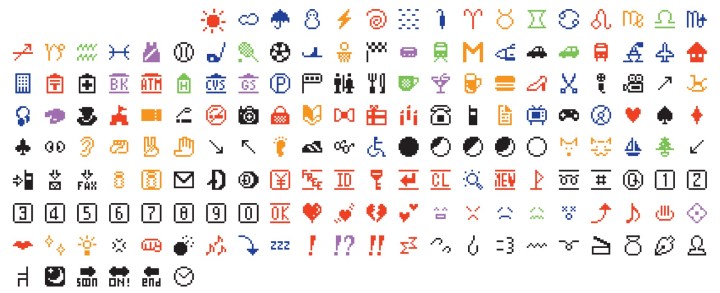
Acknowledging the global impact of the pictograms on everyday conversation, New York City’s Museum of Modern Art (MoMA) has added the original set of 176 characters to its permanent collection.
Created by Japanese designer Shigetaka Kurita for NTT Docomo as the company prepped its then-groundbreaking i-mode mobile internet system, no one could’ve envisaged just how popular they’d one day become.

“With the advent of email in the 1970s and the subsequent evolution of concise, almost telegraphic correspondence, the conveyance of tone and emotion became both harder and more urgently important,” MoMA’s Paul Galloway wrote in a piece offering some background to the new exhibit.
He goes on to explain about how, in the 1980s, “computer users in the West began composing emoticons to create simple faces out of preexisting glyphs – the ubiquitous smiley face :) is an example. In Japan, the larger character set necessitated by the language allowed for even more complicated images, giving rise to kaomoji, or picture faces, such as the now common shruggy: ¯_(ツ)_/¯.”
But the move from desktop to mobile meant people wanted an easier, quicker, and shorter way to express themselves through images. So Kurita set to work and came up with the first set of emojis (above).
As the years passed, the prominence of emoji grew as other phone companies started offering them to their users. Google made them even more popular when it incorporated them into Gmail in 2006, and their continued use was assured when Apple added them to the iPhone’s messaging app five years later.
Kurita’s set comprises just six colors, with each emoji built within a 12×12 pixel grid, which accounts for their blockiness.
“Today’s emoji (the current Unicode set numbers nearly 1,800) have evolved far beyond Kurita’s original 176 designs for NTT Docomo,” Galloway explains. “However, the DNA for today’s set is clearly present in Kurita’s humble, pixelated, seminal emoji.”
And if you’re in any doubt as to just how huge emojis have become in today’s world, take a moment to check out Matthew Rothenberg’s fabulous emojitracker, which shows the real-time use of emojis on Twitter.

